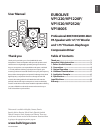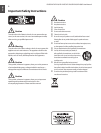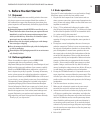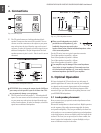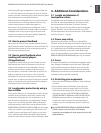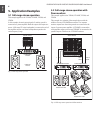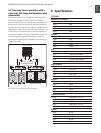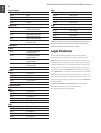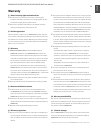
ENGLISH
EUROLIVE VP1220/VP1220F/VP1520/VP2520/VP1800S User Manual
4
Connections 2.
The VP series features two locking professional loud-
[1]
speaker [1] connectors that are wired in parallel. You can
connect one of the connectors to the output on your power
amp and tap into the signal from the amp on the second
connector, in order, for example, to feed this signal into an
additional loudspeaker. The pin designation of the loud-
speaker connector is pins 1+ and 1-. Pins 2+ and 2- are not
connected.
ATTENTION: Never connect the output signals of different
◊
power amps to both parallel inputs at the same time. This
may permanently damage your equipment.
The VP series includes two parallel ¼" TS loudspeaker
[2]
[2]
inputs. You can connect one of the connectors to the output
on your power amp and tap into the signal from the amp
on the second connector, in order, for example, to feed this
signal into an additional loudspeaker.
When several loudspeakers are wired in
◊
parallel the overall impedance Z
T
to be
handled by the power amp can be calcu-
lated, as shown below, from the individual impedance values
of the connected speakers:
For the VP series, here are typical connection scenarios:
Two 8 Ohm speakers in parallel = 4 Ohms
Four 8 Ohm speakers in parallel = 2 Ohms
Two 4 Ohm speakers in parallel = 2 Ohms
Four 4 Ohm speakers in parallel = 1 Ohm
Your amplier may be damaged if the actual impedance
◊
drops below its input impedance. Please make sure that
the calculated total impedance Z
T
is not smaller than the
minimum impedance specied for your amplier.
Optimal Operation3.
We have developed the VP series for use in a wide range of
possible applications. Of course, the sound of your loudspeak-
ers depends on the acoustic characteristics of the room/space
in which they are being used. The following chapters of this
manual will give you information about getting the most out of
your EUROLIVE loudspeakers.
Loudspeaker placement3.1
Here are some tips to get optimal sound and performance from
your loudspeaker(s):
Elevate the loudspeaker at or above head level. High frequencies
are the segment of the audio spectrum responsible for clarity
and speech intelligibility. They can get mufed by the front row
of the audience, so we recommend positioning your loudspeakers
so the high-frequency drivers are slightly above the height of the
audience. The more you can get everyone in direct earshot, the
better. Imagine the loudspeaker is a giant ashlight, and you
want to illuminate everyone in the room.
Fig. 2.1 Connector panel
Fig. 2.2 Professional loudspeaker connector
Fig. 2.3 ¼" TS loudspeaker connector
T



